Maximizing Impact with Less: The New Approach to B2B Content
The rulebook for B2B content is being rewritten, and it's all about distribution, intelligent tactics, leveraging AI, and making each piece of content count.

The B2B content landscape has completely transformed over the past few years. Now, it's all about developing a smarter strategy, making each piece of content work harder, and leveraging AI where it fits. It’s about doing more with less because marketing budgets aren’t what they used to be.
The push toward remote work and the squeeze from economic pressures have made marketers rethink how they manage content operations. But with unwieldy tech stacks and disconnected workflows, adaptive and lean teams need a cohesive approach that embraces flexibility and out-of-the-box thinking. So what’s next?
I decided to go straight to the source and ask content marketers how they’re adapting and innovating in these challenging times. Here’s what I found out.
The Change Is Here
Post-pandemic, brands are adapting, but not by going back to old ways. The shift is permanent. The content team landscape has changed for good.
Freelancers and agencies are becoming integral to content teams, offering the flexibility and efficiency that in-house employees can't always match. It’s about keeping control over costs while being able to scale up or down as needed.
The challenge is balancing the need for quality content with strategic goals in a predominantly remote work environment. But the trend is clear: quality is winning. Nobody has the bandwidth for content that doesn’t hit the mark.
How do I know? Because content queen, word maven, and editorial empress Ann Handley said so at B2BMX, and B2B copy whiz Grace Baldwin agreed.
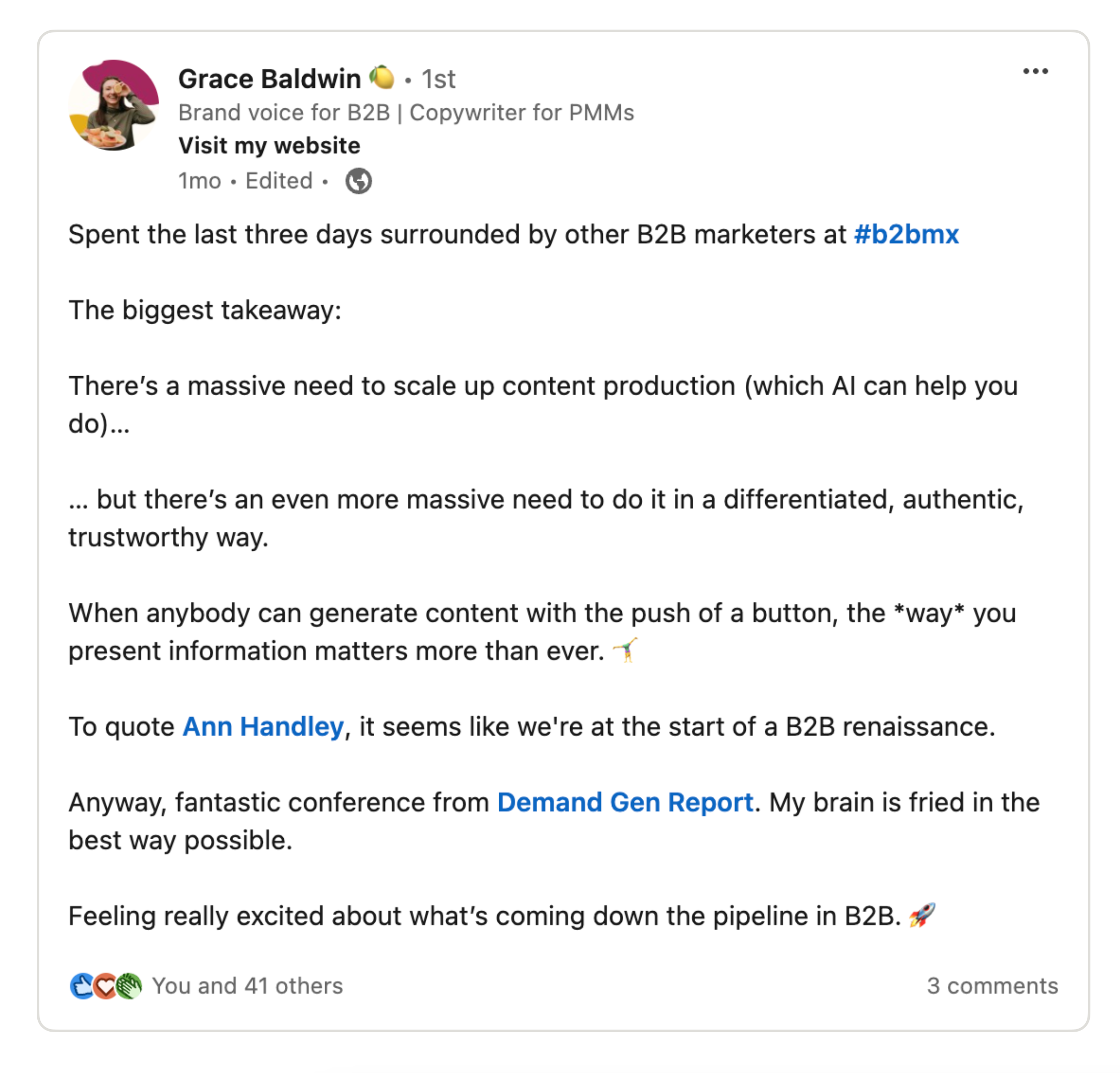
Tell Me What You Really Think
It's loud and clear from everyone in the industry: aligning content with business strategy is the number one focus.
No more worrying about doing more with less. Instead, focus on doing the right things right. Stay on track by planning with clear objectives and working backward from key goals.
The Role of Gen AI and Human Creativity
AI is a tool, not a replacement. Sure, it's revolutionizing how marketers put ideas together and draft content. But it's the human touch that tailors this content to your audience and polishes it to shine.
As Lora Schellenberg, Founder of Just Citrus, says, "Gen AI has 10xed putting together ideas and an outline, and getting some sort of content on paper. This has catapulted my creative process. I'm spending most of my time on strategy: understanding target audiences, their pain points, what UNIQUE content you can provide that's on brand for your business." It's about setting the foundation first, then building on it.
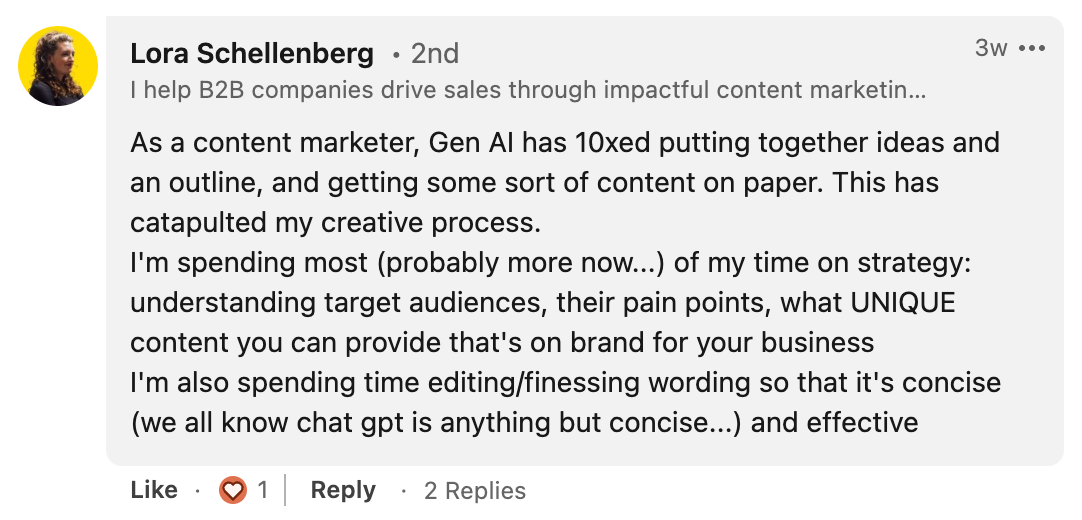
Quality Over Quantity
Marketers are pivoting toward impactful content that resonates rather than just churning out volume.
Aritra Sen, Founder & CEO of Digital Hawk, tested this theory by cutting the firm’s blog post output in half but focusing on deeper, guide-style pieces. The result? Site traffic held steady, but engagement, measured by time on page, shot up by 62%. It's a compelling argument for focusing on quality and depth over sheer numbers.
Now, let's tackle a different angle from that of Eric Doty, Content Lead at Dock. If you're sitting pretty with a massive audience and budget, going all-in on quality makes sense. But let's face it, that's not everyone’s reality. Most marketers are playing a different game, taking as many shots as possible to see what lands.
“If you're sitting pretty with a massive audience and budget, going all-in on quality makes sense. But let's face it, that's not everyone’s reality. ”
Eric's team at Dock found their sweet spot by playing the numbers. Out of every 10 SEO blogs, a couple would hit the mark. Pouring five times the effort into each piece didn't guarantee a win, making a strong case for balancing quantity with quality.
But this isn't an invitation to dive into a low-effort content frenzy. Eric champions a middle ground, pushing to scale content output without compromising quality standards for each channel. By automating manual tasks (emails to freelancers, creating briefs, sending team updates) he focuses on maintaining a solid publishing cadence without sacrificing quality.
"I think quality over everything is a cop-out to not hold yourself to a publishing cadence (one that I used to take all the time)," says Doty. It's about finding that efficiency without losing sight of what makes content great.
“It's about finding that efficiency without losing sight of what makes content great.”
Collaboration Across Teams
The digital workplace has thrown content marketers into a new era of collaboration. With tools like Slack and Teams, everyone is more connected than ever, not just within the organization but with external partners too.
Yet processes can get sticky, especially around content distribution. Expanding in-house teams can introduce fresh ideas and relieve some of that pressure.
Christopher Morris, Content Marketer at Elegant Themes, shared that it is common to lean on freelancers for plug-and-play in their system. But "expanding in-house creates more cross-pressures for new ideas," highlighting the benefits of a more integrated team approach.
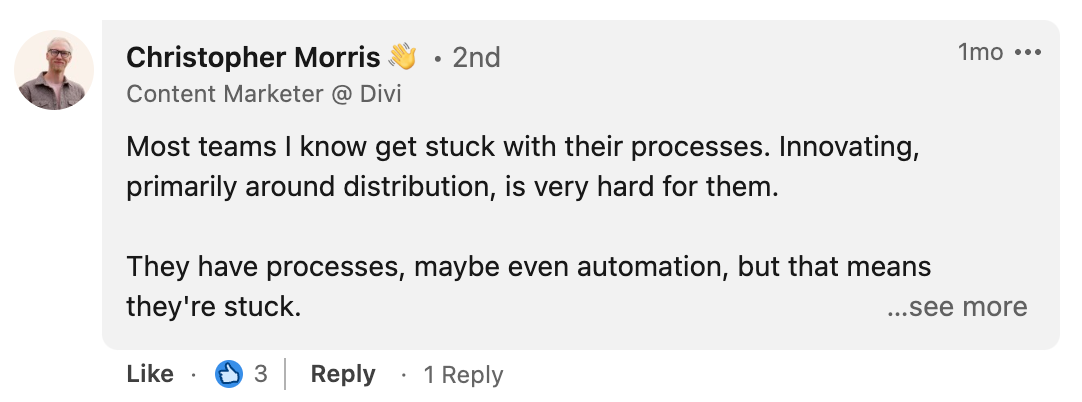
Collaboration isn’t just for in-house teams. Agencies are also starting to understand the importance of being on the same page.
Claire Trévien, Account Director at Isoline Communications, gave me some agency insight. To make the hybrid model work like a charm at her London-based tech B2B content marketing agency, they went all-in on Notion. And guess what? They're all about it.
So it’s clear whether you’re beefing up in-house teams or syncing up with external agencies, the right tools and a collaborative mindset are key to making your entire content operation smoother and more innovative.
The Humans Have It
Despite all the talk about AI, there's a clear preference for content crafted by humans. Why? Because it resonates. It has depth. It feels real because it is real.
No matter how smart AI gets, it can't replicate the genuine insights and emotions a human brings to the table. So what do these brilliant humans suggest? A smarter approach to content.
“No matter how smart AI gets, it can't replicate the genuine insights and emotions a human brings to the table.”
Strategic Repurposing and Leveraging SMEs
Masooma Memon, a B2B copywriting genius, hit the nail on the head: strategic repurposing is no longer an afterthought. It's becoming a core competency. Back when resources were plentiful, repurposing and effective distribution often got sidelined. Not anymore.
Now, it's all about creatively reimagining content. Think chopping, cutting, remixing, and finding new ways to make content work harder.
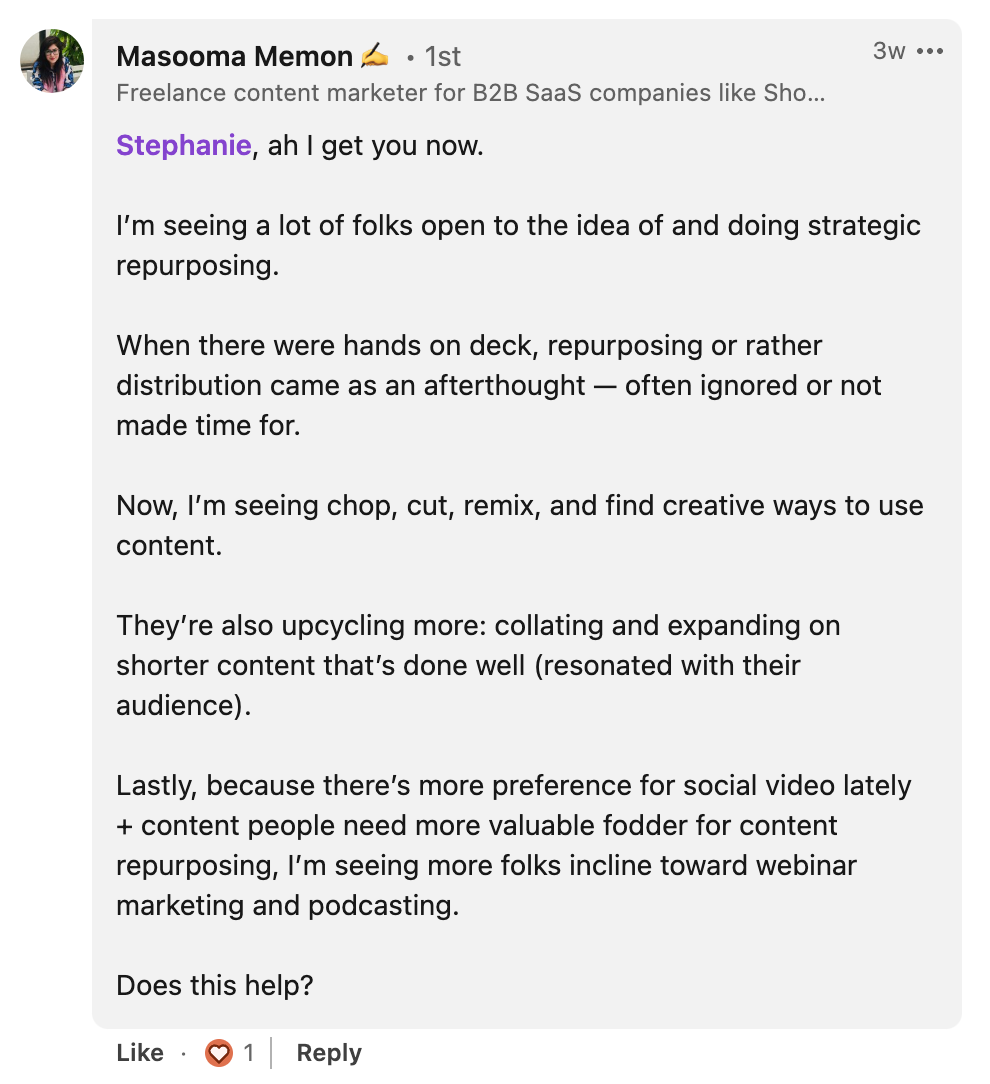
Don’t forget about upcycling. Content marketers are getting better at expanding on bits of content that have already resonated with the audience. This isn’t a rinse-and-repeat approach. It's about adding value, depth, and insight.
It’s impossible to overstate the importance of subject matter experts (SMEs). Their expertise turns what could be run-of-the-mill content into something rich and valuable. Their insights elevate content from just "good enough" to truly engaging and effective.
“Writing is expensive, and for many companies, it's too expensive to keep in-house.”
Outsourcing Over In-House Production
More teams are choosing to work with freelancers and external agencies instead of expanding their in-house staff. Superpath’s State of Content Report found that ~42% of teams increased their spend on freelancers. And like Jimmy Daly, Cofounder and CEO of Superpath, said, “Writing is expensive, and for many companies, it's too expensive to keep in-house.”
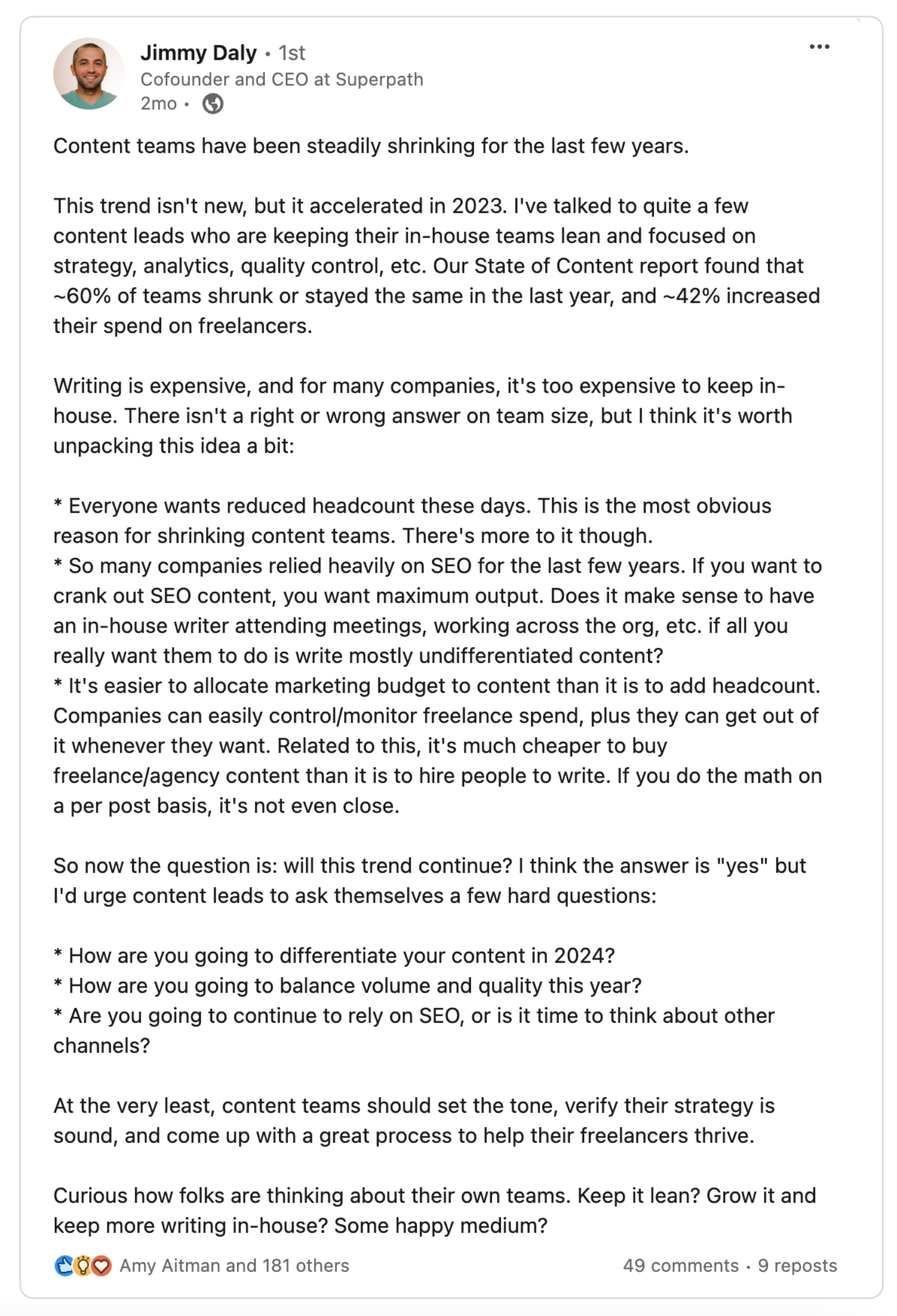
This shift is about tapping into the flexibility and diverse perspectives that outside experts bring to the table. It's a strategic move to keep content operations nimble and innovative by leveraging the best talent available, wherever they are.
Bottom of Funnel (BOFU) Content
The focus is intensifying on BOFU content. Rich in product knowledge, it’s crafted to inform and convert.
Marketers are investing more in content that directly addresses customer needs and guides them toward purchasing. It reflects a deeper understanding of the audience and what moves them.
Some may think only in-house writers can handle this type of content. But there are plenty of differing opinions like this one from freelance writer Amanda Scheldt.
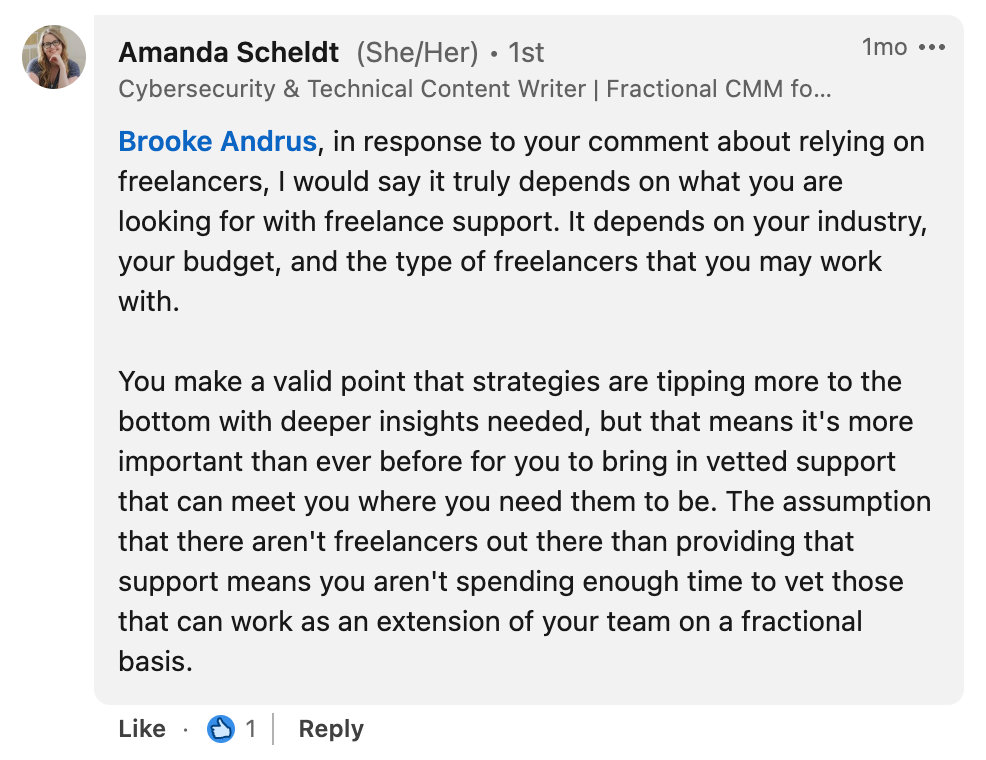
Content as a Key Business Driver
Content is more than a marketing tool. It's fundamental to business growth. Producing content means investing in your business's growth.
It has the capacity to pull in your audience, build trust, and ultimately drive conversions. The shift toward recognizing the true value of content is a trend that’s likely to grow.
Kory Underdown, Senior Content Manager at DNSFilter, confirmed just how effective quality content can be for building pipeline. Her marketing team of two brought in 66.6% of all pipeline.

Strategies for the New Normal
Navigating these changes in content marketing means getting straight to the point, understanding your tools and team, and ensuring everyone’s rowing in the same direction.
Building a Foundation
First things first, get your house in order. This means having clear documentation, defining your brand voice, and setting up style guides everyone can follow.
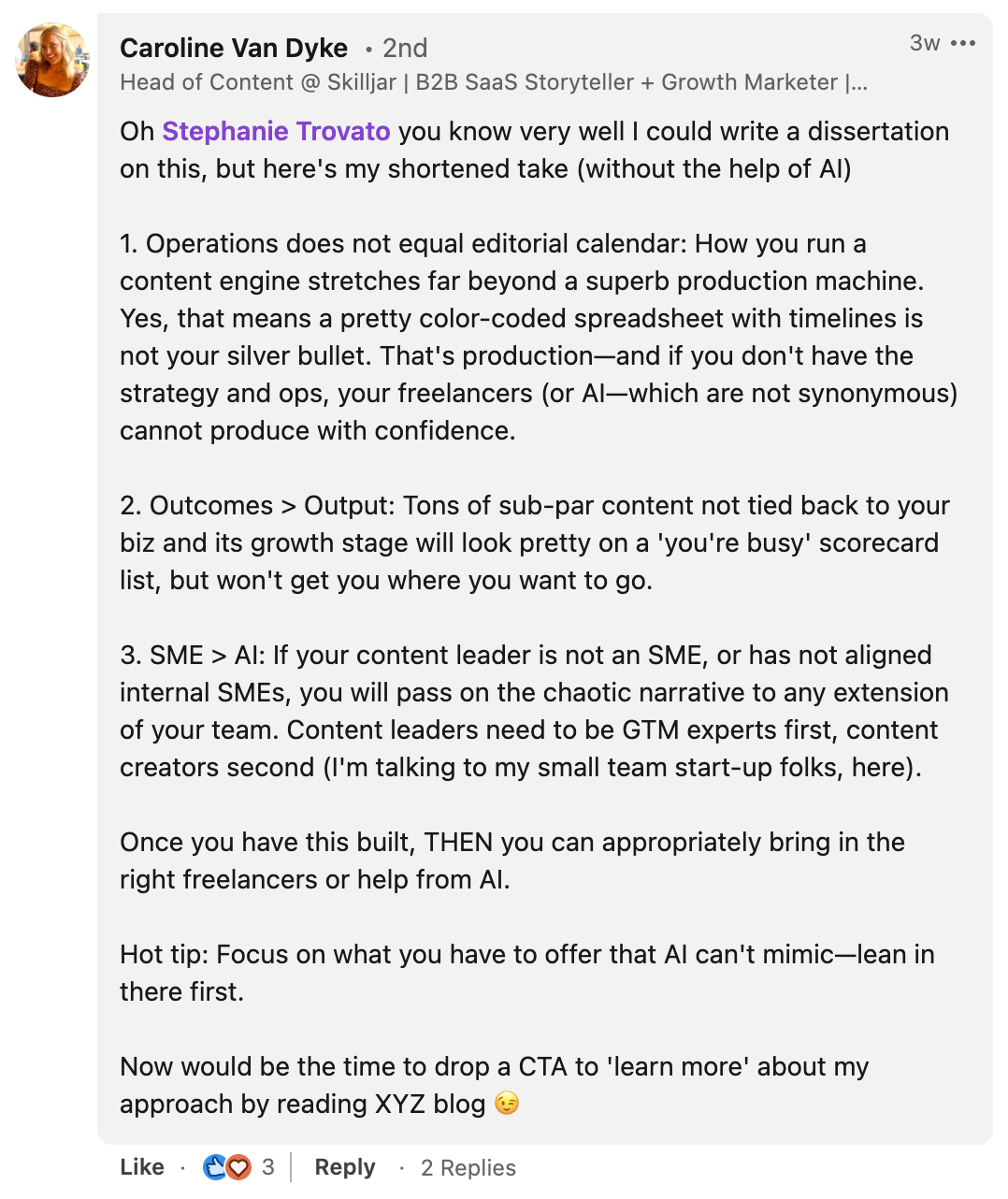
Caroline Van Dyke, Head of Content at Skilljar, gets it. Give freelancers the tools they need to know and speak your brand. Onboard them properly and define a way to manage their work. These key moves will ensure they’re contributing in ways that align with your goals.
This documentation is just as helpful for in-house staff. Just ask Erika Heald, Founder and Chief Content Officer of Erika Heald Marketing Consulting, who shares, “Human content creators throughout your organization and AI tools alike benefit from your taking the time to document your brand voice, build out comprehensive style guides, and have processes documented.”
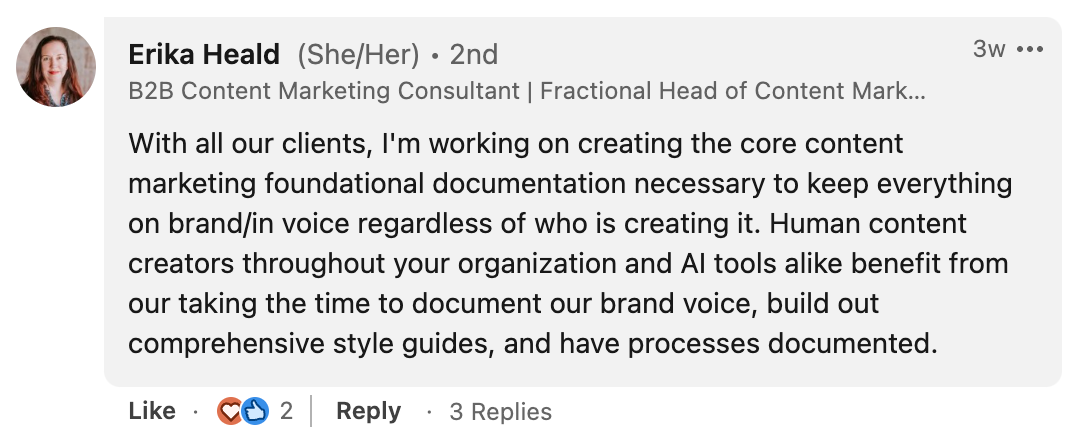
Beyond the Editorial Calendar
Let's be clear: there's more to content management than just churning out articles and posts. You need a strong strategy and operational model to ensure your efforts lead to real results.
Content management means thinking big picture. Every blog post, social media update, and email campaign should tie back to business goals. Are you looking to grab more leads, boost your brand, or keep your customers coming back for more? That's where your content should focus.
It's all about impact over quantity. In a sea of content, what makes yours stand out is its ability to actually do something: drive action, spark conversations, or convert leads. That's the measure of success.
Leveraging Talent and Technology
You're pulling together a team that blends your in-house experts, freelancers, and yes, even AI, to bump up both the quality and efficiency of your content. That freelancer bench you've built up? It's your ticket to getting content strategies off the ground quickly, no matter the project or deadline.
Joshua Palmer, Head of Content at OnBoard, knows all about the bench potential. He values his freelance bench and the opportunities they grant his internal team.
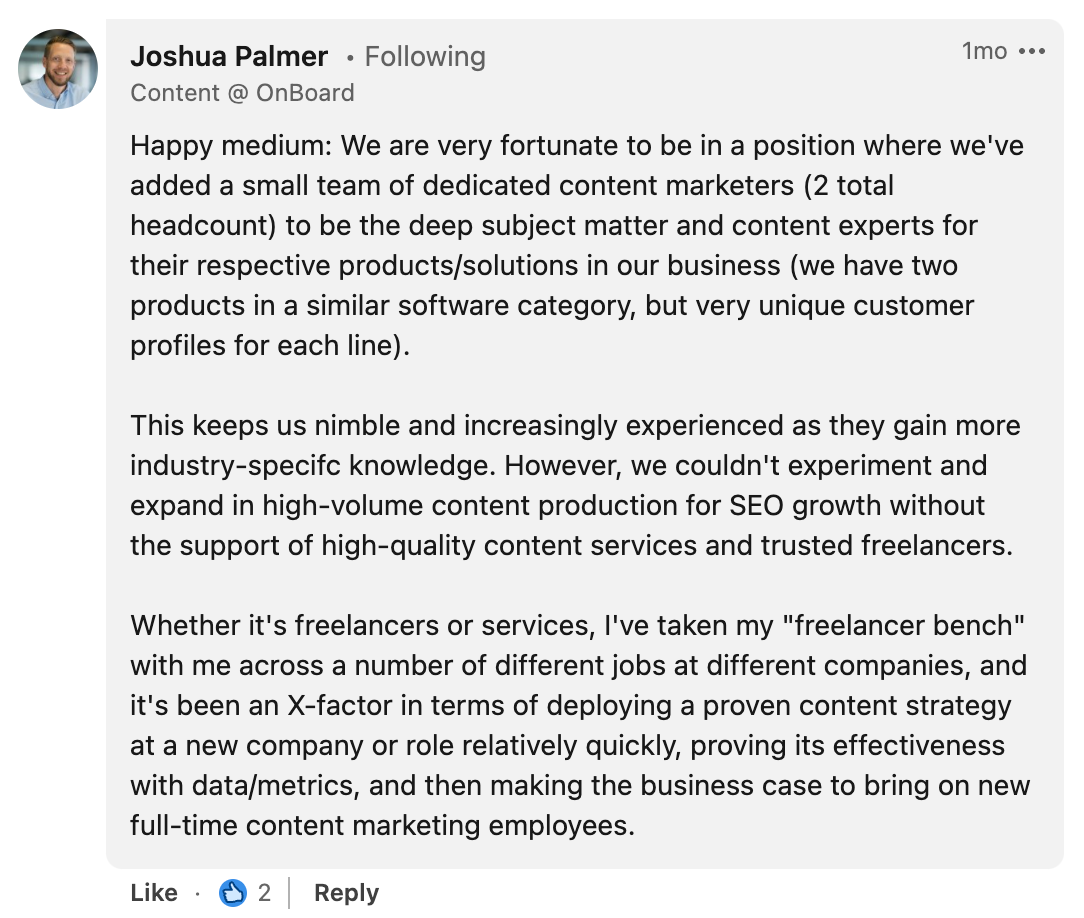
The game here is blending human creativity with AI's knack for efficiency. This combination is what keeps your content top-notch and your workflows slick.
Future-Proofing Your Content Efforts
Adapting to the changes in B2B content means more than just keeping pace with today. You need to look ahead and anticipate what comes next. Here’s how:
- Hybrid Workflows: Adopt a hybrid approach that marries AI's efficiency with human creativity. Get comfortable with tools that automate the mundane (think content scheduling and analytics) while carving out space for human-driven strategy sessions that AI can't replicate.
- Content Personalization at Scale: With AI evolving, expect content personalization to become necessary. Use AI to sift through data and spot trends, helping you tailor content that feels one-on-one, even when it's one-to-many.
- Collaborative Ecosystems: Future content operations will thrive on collaboration. Platforms like Notion are just the beginning, promoting a seamless integration where freelancers, teams, and AI tools work together efficiently and harmoniously.
- Sustainability in Content: Addressing digital pollution will become crucial, making focusing on sustainable content practices essential. This includes prioritizing long-lasting content, reducing digital clutter, and being mindful of the brand’s digital footprint.
- Agile Methodologies: An agile content strategy allows for quick pivots and adaptations. It emphasizes brief, focused efforts, ongoing feedback, and the flexibility to abandon what doesn’t work in favor of innovative approaches.
Charting the Course Forward in B2B Content
Let's get one thing straight: B2B content is different, and that’s okay. You’re now playing in a space where strategy, efficiency, and collaboration are the pillars holding up your work. Mixing human expertise with AI is your current state, making your content smarter and your processes smoother.
This shift impacts everyone, from how you think about your role to how you carry out your daily tasks. It's a call to action for everyone in this space to adapt, innovate, and think critically about where content marketers fit into this new landscape. The key is not having all the answers but being willing to explore, experiment, and find what works best for your team.
At Relato, we’re right there with you, navigating the evolution of B2B content. We believe in the power of collaboration, innovation, and above all, the flexibility to adapt and thrive.
Ready to join the conversation and stay ahead of the curve? Sign up for early access and share your experiences and strategies.
Apply for early access to Relato
- Secure your invite for early access
- Give feedback, have your say
- Receive news and updates